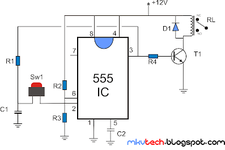hafrse
Full Member level 3
Hello,
I have built an electronic latching switch with 555 based on a circuit diagram I found on the net. the circuit is not connected to a relay now , when I push and release the button, the output goes high at pin 3 as excpected , but when I pusg aging, the output at pin 3 goes low (0V) after a number of attempts. So, on is no problem but off it needs multiple attempts to get pin3 low.
Any clue what that could be?
R1,R2,R3-1k Ohms Resistor
R4-100 Ohms Resistor
D1-1N4007 Diode
C1-1uf Capacitor
C2-10n Capacitor
Thanks
I have built an electronic latching switch with 555 based on a circuit diagram I found on the net. the circuit is not connected to a relay now , when I push and release the button, the output goes high at pin 3 as excpected , but when I pusg aging, the output at pin 3 goes low (0V) after a number of attempts. So, on is no problem but off it needs multiple attempts to get pin3 low.
Any clue what that could be?
R1,R2,R3-1k Ohms Resistor
R4-100 Ohms Resistor
D1-1N4007 Diode
C1-1uf Capacitor
C2-10n Capacitor
Thanks
Attachments
Last edited:


